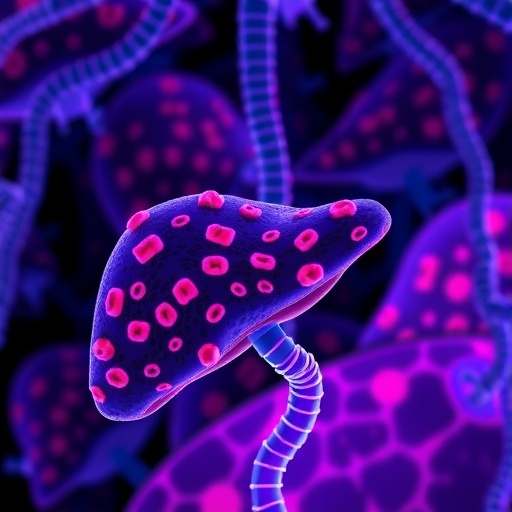In the field of biomedical research, liver cirrhosis represents a significant global health issue that continues to pose serious challenges in treatment approaches and patient management. With thousands of individuals affected every year, researchers are under increasing pressure to develop more effective therapeutic strategies to combat this debilitating condition. A groundbreaking study by Zheng and colleagues has opened up new avenues for potentially innovative treatments that specifically target macrophage regulatory mechanisms, aiming to reshape our understanding of this chronic disease and its management.
Liver cirrhosis is the end-stage manifestation of chronic liver disease, characterized by extensive hepatic fibrosis and resultant deterioration of liver function. The etiology of cirrhosis can vary, with chronic alcohol abuse, viral infections, autoimmunity, and metabolic disorders being major underlying causes. As the liver is crucial for numerous bodily functions including metabolism and detoxification, the ramifications of cirrhosis on overall health are profound and can lead to complications such as hepatic encephalopathy, portal hypertension, and increased risk of liver cancer.
In their study published in the Journal of Translational Medicine, Zheng et al. highlight the role of macrophages in liver pathology. Macrophages serve as pivotal components of the immune system, possessing the capability to polarize into different phenotypes that can either exacerbate or resolve inflammation. The dysregulation of these immune cells within the liver microenvironment is a decisive factor contributing to the progression of liver diseases, including cirrhosis. The authors suggest that by targeting macrophage regulatory mechanisms, it may be possible to modify the disease trajectory significantly.
Targeting macrophages as a therapeutic strategy is particularly compelling given their prominence in mediating inflammatory responses within the liver. Their plasticity allows them to adopt pro-inflammatory or anti-inflammatory states depending on the local microenvironment. In patients with liver cirrhosis, it is often observed that there is a shift towards a pro-inflammatory macrophage phenotype. This perpetuates a cycle of inflammation and further fibrogenesis, worsening the condition. Therefore, reprogramming macrophages to assume a protective role could have transformative effects on patient outcomes.
Zheng and his team delve into several potential avenues for manipulating macrophage behavior. One innovative approach involves the use of small-molecule compounds that can effectively reorient macrophages towards an anti-inflammatory state. The transition from a M1 (pro-inflammatory) to a M2 (anti-inflammatory) phenotype represents a potential therapeutic goal, fostering an environment conducive to tissue repair and regeneration within the damaged liver.
In addition to pharmacological interventions, the study also explores the potential of gene therapy as a means to influence macrophage function. By employing techniques such as CRISPR-Cas9 to modify genes responsible for macrophage polarization, researchers hope to establish more durable changes in macrophage behavior that would promote healing and mitigate fibrosis. Although challenges remain in delivering such therapies effectively to the liver, the results from preliminary studies show encouraging promise.
Zheng et al. further emphasize the importance of the liver’s unique microenvironment and the role it plays in macrophage activation. Notably, the presence of various stimuli, such as cytokines and growth factors, shapes how macrophages respond to liver injury and influences whether they contribute positively or negatively to the healing process. The identification of specific signaling pathways involved in macrophage activation represents a critical step in devising strategies to selectively inhibit detrimental macrophage responses while enhancing positively reparative actions.
The implications of this research extend beyond liver cirrhosis, potentially informing the treatment of other fibrotic diseases. Similar macrophage-driven inflammatory processes are also observed in conditions affecting the lungs, kidneys, and heart, suggesting that insights gained from this study may apply widely across various organs and conditions. The ability to leverage macrophage biology could revolutionize our approach to not just cirrhosis, but a broad array of inflammatory diseases.
As this work progresses, researchers are faced with further challenges, including the need for extensive clinical trials to assess the safety and efficacy of these novel interventions. While preclinical data is promising, translating these findings into real-world treatments demands meticulous consideration of numerous factors, including patient heterogeneity, the stage of disease, and potential side effects associated with macrophage modulation therapies.
The urgency of advancing liver cirrhosis treatments cannot be overstated. The chronic nature of this disease, coupled with its complications, necessitates innovative strategies that differ markedly from traditional approaches focused primarily on managing symptoms. By redirecting focus towards the immune system’s intricacies, particularly macrophages, Zheng and his team could be laying the groundwork for a new paradigm in addressing liver cirrhosis that emphasizes restoration of normal immune function over mere symptom alleviation.
Insights from this study also align with an increasing interest in personalized medicine. By understanding the unique macrophage profiles present in different patients, it may be possible to develop tailored therapies that reflect individual disease pathways and immune profiles. This could improve treatment outcomes and ultimately lead to more sustainable long-term management strategies for patients afflicted by liver cirrhosis.
In conclusion, the research conducted by Zheng et al. provides an exciting glimpse into the future of liver cirrhosis treatment. By targeting macrophage regulatory mechanisms, they pave the way for potentially innovative therapies that can shift the narrative of this debilitating disease from one of inevitability to one of hope and recovery. As the scientific community builds upon these findings, the goal will be to translate laboratory discoveries into tangible clinical solutions that improve quality of life and outcomes for those facing the challenges of liver cirrhosis. The journey ahead is undoubtedly complex, but the promise held in these new approaches signals a brighter future for liver disease management.
Subject of Research: Liver cirrhosis and macrophage regulatory mechanisms
Article Title: New perspectives in the treatment of liver cirrhosis: targeting macrophage regulatory mechanisms.
Article References:
Zheng, S., Li, S., Wang, Q. et al. New perspectives in the treatment of liver cirrhosis: targeting macrophage regulatory mechanisms.
J Transl Med 23, 1201 (2025). https://doi.org/10.1186/s12967-025-07239-y
Image Credits: AI Generated
DOI: 10.1186/s12967-025-07239-y
Keywords: Liver cirrhosis, macrophages, immunotherapy, fibrosis, inflammation, personalized medicine, regenerative medicine




